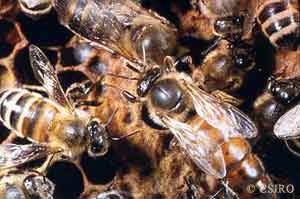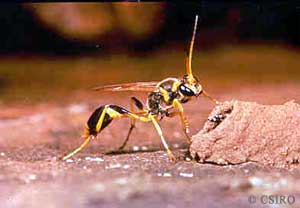|
Hymenoptera:
ants, bees and wasps
|
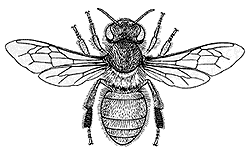
Apis mellifera (European honeybee)
|
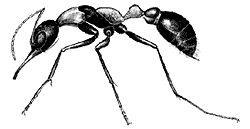
Myrmecia nigrocincta |
|
Characteristics
There
approximately 14 800 Hymenoptera species in Australia and it is
estimated that 4000 of these are ant species. The name Hymenoptera
means 'membrane wings'. This order is large and diverse and includes
groups of insects, which may appear to be unrelated due to their
differing appearances. However all hymenopterans share the following
characteristics:
- Two pairs
of membranous
wings, although some may be wingless such as some species of female
wasps and the worker caste of ants
- The forewings
are larger than the hind wings and are held together by small
hooks (see below)
- Females
usually have a hardened ovipositor,
which may be modified for sawing, piercing or stinging
- Most hymenopterans
have a constriction between the first 2 segments of the abdomen,
which is known as a 'wasp waist'
- Chewing
(mandibulate)
mouthparts, although in some species such as bees the lower lip
is modified to form a tongue
The larvae
of hymenopterans lack many of the above external features. They
vary in body shape and size depending on the species. Some display
a distinct head,a thorax with 3 pairs of legs and an abdomen, although
most are grub-like with no legs.
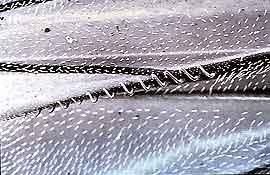
Wing hooks of a wasp |
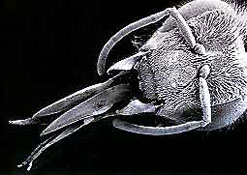
Bee tongue |
| The wing
hooks of Hymenoptera enable the wings to be coupled together
during flight, which gives these insects well controlled, rapid
flight. These tiny hooks can be easily seen with the aid of
a dissecting microscope. |
The
mouthparts of bees have been slightly modified to form a long
tube and a hairy tongue which is used for sucking up nectar
from flowers. The mouthparts of honey bees are classified as
chewing and lapping types and consist of a pair of mandibles
on either side of the head and a long tongue. |
The Hymenoptera
is divided into 2 suborders. The Symphyta (sawflies) who have no
discernible waist and the Apocrita (ants, bees and wasps) who have
a distinct waist.
The Hymenoptera
are quite a distinctive order and members are unlikely to be confused
with other insects. Some of the smaller winged species may appear
to only have 1 pair of wings and may be mistaken for flies
(Diptera). Sawfly larvae are very caterpillar-like in
appearance and may be mistaken for caterpillars (Lepidoptera).
Life Cycle
Hymenopterans
have a complete
life cycle, which varies slightly depending on the species.
Some females can produce young without mating, while others can
store sperm and spread out their egg laying to coincide with available
food. Most species will lay their eggs on the appropriate host plant
or on paralysed food sources they have gathered into specially constructed
nests.
A variation
of this occurs with social insects such as ants and bees, where
special castes provide food for the developing larvae. The larvae
will moult
several times before they pupate. Development may range from a few
weeks for some parasitoids,
to much longer in social species.
Feeding
Hymenopterans
feed on a wide range of foods depending on the species. Adult wasps
mostly feed on nectar and honeydew and can often be seen at flowers.
Some species are predators or parasites and spend their time searching
out invertebrate hosts to lay their eggs on. The feeding habits
of adult ants vary and may range from specialist to generalist predators,
scavengers
and omnivores,
to seedeaters, fungus feeders or honeydew feeders.
Habitat
Hymenopterans
are found in nearly all terrestrial habitats throughout Australia
and may occur in soil, leaf litter and a range of vegetation types,
especially flowers. Some species are often observed drinking at
the edges of water or gathering mud that is used to construct nests,
often in man-made environments.
For information
on some of the more common species of Hymenoptera in Australia visit the Entomology Fact Sheets pages.
|





